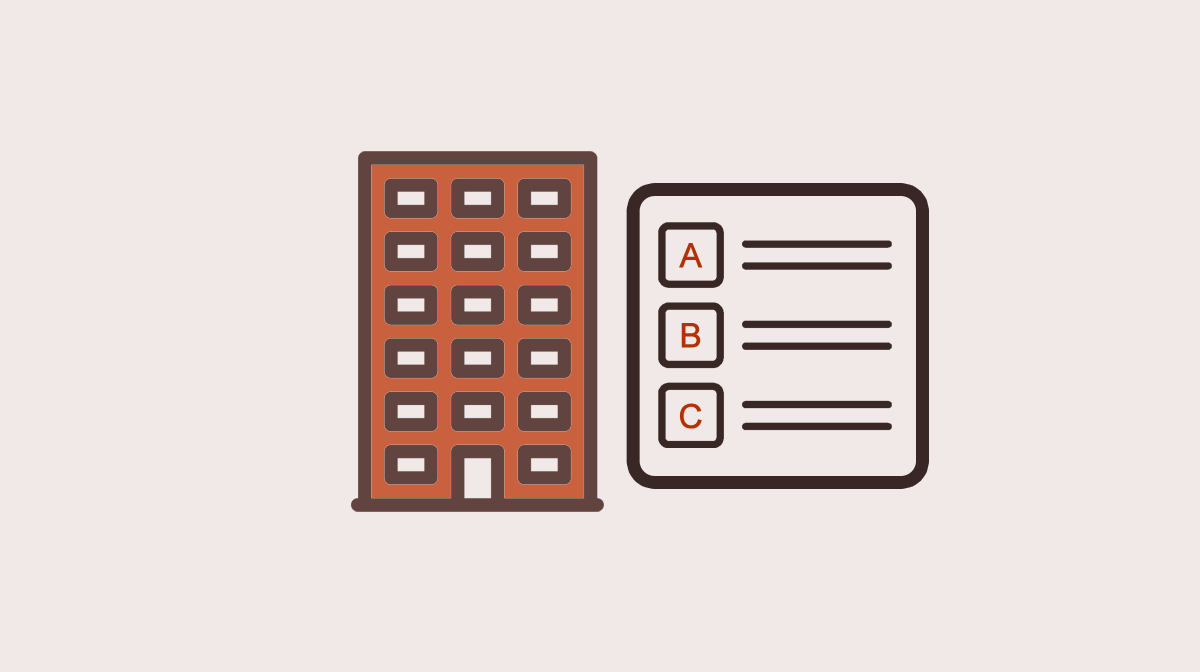It costs a lot of money to buy an apartment building. Most landlords need to borrow money from a bank to buy them. But banks have a scoring system that they use to figure out how much money they'll allow landlords to borrow. Running an apartment building is a lot like running any other business. Banks know that businesses are likely to fail. When a landlord fails, the bank gets ownership of the building. Banks will only lend money to high scoring buildings so that they know that they'll be able to find a new owner quickly.
The way the banks score buildings includes the age of the building, the style of management and the surrounding neighborhood. This is one of the major reasons why you only see a few types of buildings in each neighborhood. Downtown will only have new high rises. The edges of town will only have old creaky walkup buildings. It also affects who is likely to buy each type of building.
Today we'll take a look at the four main scores a building can have, and who is most likely to own them.
Class A
Class A buildings are brand new, usually less than 20 years old. They have a lot of units, and lots of community features like gyms, pools and party rooms. They have professional property management on site at all times. They're located in very popular neighborhoods. They're probably high rises with many eco-friendly features. They usually have a fancy name, like Aqua or K2.
The landlord for a Class A property is probably a big corporation. The owning corporation may be based in another country. Lots of money is available to buy Class A buildings as they're very low risk to the bank if the landlord fails and has to sell the building. You'll see all kinds of companies competing to lend money to buy Class A buildings.
The primary goal of a Class A landlord is to reduce turnover. They will court high-income tenants with lots of luxuries, events and prestigious businesses on site. These owners want a long-term passive investment. They'll sit and enjoy the income on a large property for as long as it commands top dollar rents.
Class B
These buildings are older than Class A and may be starting to get a little rough around the edges. 20 years ago they were the new hotness, but now they're kind of dated. They usually still have professional onsite management, but it's limited to a doorman and a couple of custodians. They're not in the best neighborhoods, but they may be near a local point of interest like a college or airport.
Class B buildings are also owned by shareholder-style corporations. Banks will still lend money to help buy them, and some industry specific companies will also be interested in providing funds. However, these owners may be newer, less-established or smaller companies. They're looking for the higher income that comes from owning a slightly riskier property.
These owners usually have a goal of renovation. They want to make the needed updates to bring the building up to Class A status, at which point they may sell it and start over. Of course this means that the rent rates will certainly go up to keep pace with the renovations.
Class C
These are the oldest, most dated buildings, in acceptable but boring neighborhoods. In Chicago this describes most “vintage” buildings north of 35th and east of Western Ave. They have no major amenities. Some may have coin op laundry rooms in the basement. There may be an on-site super living in one of the apartments or the landlords may live in the building themselves.
It's very difficult to borrow money to buy Class C buildings. Local banks might be willing to lend for the best of them, but in most cases the landlord will have to use cash. Most of the owners will be individuals or small partnerships that buy the buildings with cash or with a personal line of credit.
Owning a class C building is a big risk for landlords but it can bring about big rewards. Low income tenants that rent in these buildings tend to be the most likely to require evictions, and the buildings also have the highest crime rates. It takes a brave landlord to take on a Class C building and they usually have only one goal in mind – they want money. Because they don't have a loan to pay down, they can recoup their investment the fastest with these older buildings. This means they're the least likely to invest in anything beyond the bare bones necessary to keep the apartments occupied.
Class D
These are basically Class C buildings in the worst neighborhoods. They are occupied predominantly by government subsidized renters and the residents are almost all low-income. Crime rates are usually high and the tenants can be very hard on the property. Many of the tenants will regularly be unable to pay the rent.
The money scene for Class D buildings is about the same as Class C – nonexistent. Anyone who wants to buy a Class D building must have cash on hand and nerves of steel.
Your standard Class D landlord is a specialist in working with Section 8 system. They may be an attorney so that they can handle the many necessary evictions themselves. They are, like Class C landlords, focused on the money. They may not have the cash on hand that would allow them to buy a Class C building. Alternately they may be so concerned about getting the most return on their investment that they buy without care about the location of their property.
Accidental
There is no real bank “class” for the accidental landlord, but many of them exist. These are homeowners and condo owners who opt to rent out their former homes instead of selling them. They didn't buy the property deliberately as an investment.
Most of these landlords are just looking to earn enough to cover their costs of ownership until such time as they can sell off the property and make a profit. They may be from a family with experience in property management, or they may owe more on their mortgage than the property is currently worth. Unlike most landlords these folks do not have a business plan, business model or training in local landlord-tenant law.
Banks were banned from using race and class as a way to determine who was eligible for loans as part of the fair housing act. However, this building class system when combined with city land use, zoning laws and access to public transit may be seen to have an equivalent effect. There is no money available to buy or build a Class A building in a Class D neighborhood, and the type of landlord who is likely to buy a Class D building isn't the sort to want to add the amenities necessary to upgrade it from one to the other. Our natural focus on location as a factor in housing – even if its rented – will keep neighborhood quality a necessary factor to consider when lending money to landlords no matter what laws are in place.
RentConfident is a Chicago startup that provides renters with the in-depth information they need to choose safe apartments. Help us reach more renters! Like, Share and Retweet us!


